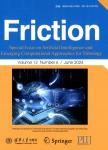The viscosity at the glass transition of a liquid lubricant
The viscosity at the glass transition of a liquid lubricant作者机构:Center for High-Pressure Rheology George W.Woodruff School of Mechanical Engineering Georgia Institute of Technology
出 版 物:《Friction》 (摩擦(英文版))
年 卷 期:2019年第7卷第1期
页 面:86-91页
核心收录:
学科分类:0817[工学-化学工程与技术] 08[工学] 0805[工学-材料科学与工程(可授工学、理学学位)] 0802[工学-机械工程] 0801[工学-力学(可授工学、理学学位)]
主 题:elastohydrodynamic lubrication glass transition high pressure viscosity EHL friction
摘 要:In the classical study of elastohydrodynamic lubrication(EHL) which does not employ real, measurable viscosity in analysis, the possibility of a glass transition has not been considered in many years. Indeed, the two rheological assumptions of classical EHL, the Newtonian inlet and the equivalence of a traction curve to a flow curve, would not have persisted so long had the pressure dependence of the viscosity been accurately stated. With the recent appearance of viscosity obtained from viscometers in EHL analysis, the possibility of a glass transition in the contact should be reexamined, especially for the fragile traction fluids. This article employs published data for a synthetic cycloaliphatic hydrocarbon to estimate the glass transition viscosity so that, when using real viscosities in EHL simulations, the state of the liquid may be assessed. Far into the glassy state the liquid should be treated as an elastic solid with a yield stress.



